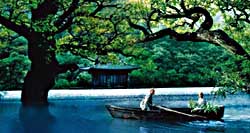Sensual satori in a floating world
By KAORI SHOJI, The Japan Times, Oct 27, 2004
Tokyo, Japan -- "Hot" is how the Japanese describe their neighbors in South Korea. For many of us, Korea and its people symbolize a feverishness and color foreign to the bland Japanese sensibility. Compared to Koreans, the recent "Kanryuu (Korean Wave)" has only enhanced our conviction that we're listless and boring, prisoners of our own ennui.
 And now with the arrival of South Korea's multiple award-winning "Spring, Summer, Fall, Winter . . . and Spring," the Japanese will see that, even in a film with Buddhist themes, the overall tone is secular, sensual and hot, hot, hot!
And now with the arrival of South Korea's multiple award-winning "Spring, Summer, Fall, Winter . . . and Spring," the Japanese will see that, even in a film with Buddhist themes, the overall tone is secular, sensual and hot, hot, hot!
But then, maybe this isn't a Korean thing, but a director thing: South Korea's Kim Ki Duk has an impressive record of churning out highly stylized stories exploding with sex and violence. So, is it any wonder that, through his lens, Buddhism (and let's not forget this is the austere, northeast Asian branch of it) acquires an altogether different sort of sheen? In this film, even the faces on the Buddhist statues seem to express an inner fire, their lips almost on the verge of some passionate confession.
The whole of "Spring" takes place in a tiny wooden temple that floats on a lake that is isolated from the outside world by lush forests and mountains. The main characters are two monks in the various stages of their lives, dressed in baggy cotton habits and sleeping on thin mattresses with seemingly no personal possessions. But what Kim achieves here is a maximum level of sensuality with the most minimal of materials (i.e. the polar opposite of "Troy"): Every scene is resplendent with sensory visual pleasures. That old Zen adage of less being more certainly applies here.
Divided into five neat segments, "Spring" shows the recurring cycle of life, lust, love, death and life renewal.
Spring sees a middle-aged monk (Oh Yeong Su) and his 7-year-old protege (Kim Jong Ho) going about their routines in the floating temple. The boy finds diversion in strapping rocks to forest animals and then giggling as he sees them struggling to get free. One morning the boy wakes up to find a sizable rock tied to his own back. He cries out for forgiveness, but the master tells him he must first find the tormented creatures and set them free. It turns out that most of them are dead and the monk gravely tells his charge that from now on, he will bear a metaphorical rock forever.
Years pass, and it's summer. A young woman (Ha Yeo Jin) comes to the temple to be cured of an unspecified illness. Now in his late teens, this is the first time the young monk (Seo Jae Kyeong) has been in such close proximity to a woman, and he falls for her within seconds of their meeting. It's not long before sex has both of them in its grip, and in the confines of the one-room temple, they manage to get together every night even though the master is sleeping only a meter away.
When their relationship is discovered, the girl is banished from the premises and the elder monk warns his disciple that lust leads to the desire for possession which in turn leads to murder. With those ominous words upon him like a curse, the young monk leaves. Many years later, he returns as a man in his early 30s (Kim Young Min), this time as a fugitive wanted for murder.
Though it's tempting to look for a moral in this tale, it's hard to find one, as the tone is never preachy or judgmental. Instead of indicting the young monk for his actions, the master is always exhorting him (silently, through action or facial expression rather than words) to expel his demons and attain inner peace. That's not as corny as it sounds, and there are many points in the story where the tension is dispelled by moments of humor or Kim's special brand of wit.
When two cops come in pursuit of the young monk, they hang around the temple, fiddle with their cell phones and annoy the master by throwing their soft-drink cans into the pristine lake. The master, instead of delivering a big lecture, later gets them to go down on their knees to help carve the words of a mantra onto the temple floor. There is no thunderclap of satori -- the cops just really get into the carving (working silently for hours). Then, when it's done, they handcuff the young monk and escort him back to the city.
There's probably something in here about how suffering is an illusion, or the effects of manual labor on the soul -- but rather than draw such conclusions, the viewer is more likely to be feeling like the three men leaving the temple: hushed, reverent and strangely serene.
Spring, Summer, Fall, Winter ... and Spring
Rating: * * * * (out of 5)
Director: Kim Ki Duk
Running time: 102 minutes
Language: Korean
Opens Oct. 30 (in Japan)

 And now with the arrival of South Korea's multiple award-winning "Spring, Summer, Fall, Winter . . . and Spring," the Japanese will see that, even in a film with Buddhist themes, the overall tone is secular, sensual and hot, hot, hot!
And now with the arrival of South Korea's multiple award-winning "Spring, Summer, Fall, Winter . . . and Spring," the Japanese will see that, even in a film with Buddhist themes, the overall tone is secular, sensual and hot, hot, hot!